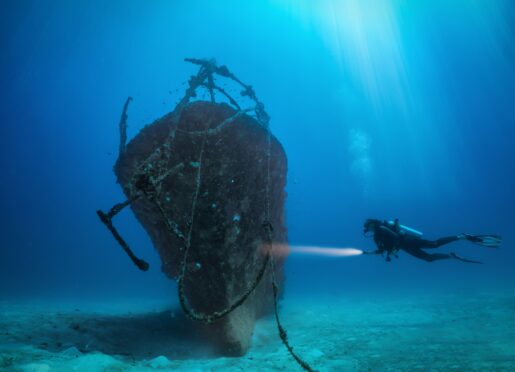
Millions of shipwrecks lie scattered across the ocean floor around the globe, waiting to be discovered as historical time capsules or even treasure troves.
Alan G Jamieson tells Laura Smith the Honest Truth about shipwrecks and the people who go in search of them.
How many shipwrecks are there around the world?
Unesco claims there are around three million shipwrecks but this is probably an underestimate. The figure does not include fishing vessels, which have been, and sadly still are, the types of ship most likely to be lost at sea.
What can we learn from exploring shipwrecks
An undisturbed historic shipwreck can function as a time capsule, giving a glimpse of a way of life frozen the moment the ship was lost. For example, the 3,000-year-old Uluburnum wreck, found off the southern coast of Turkey in the ’80s, gave archaeologists a unique picture of life and trade in the eastern Mediterranean during the Late Bronze Age.
What interesting discoveries have been found in shipwrecks?
Finds vary from ship to ship over the centuries but sometimes shipwreck archaeology can bring reality to events previously only known in literary sources. For example, classical authors describe many naval battles between Romans and Carthaginians but until recently there was little evidence of these battles. Since 2010, 19 bronze warship rams have been brought up from the sea near the Egadi Islands, west of Sicily, giving evidence of the naval battle that took place there in 241 BC. One ram even has a Carthaginian inscription saying that this ram “eats ships”.
How has maritime archaeology evolved?
The emergence of scuba diving in the ’50s allowed access to shallow water wrecks. At the start of the ’60s, archaeologist George F Bass showed that the methods of land archaeology could be applied to underwater wreck sites. Remotely operated underwater vehicles allowed deeper wrecks to be located. However, they needed a long cable from a ship on the surface. Now autonomous underwater vehicles are free of such cables. One recently found the wreck of Shackleton’s Endurance in Antarctica.
Who are some famous shipwreck hunters?
Those who look for shipwrecks divide into two usually antagonistic groups: treasure hunters and maritime archaeologists. Probably the most famous treasure hunter was Melvin Fisher who for 16 years searched for the Spanish galleon Nuestra Senora de Atocha, wrecked in 1622 off the Florida Keys. He finally found the main wreck site in 1985 and recovered treasure said to be worth $400 million.
On the other side of the divide is Robert D Ballard, who since his discovery of the wreck of the Titanic has gone on to find many other historic wrecks, including the German battleship Bismarck and President John F Kennedy’s patrol boat PT109.
Are shipwrecks protected?
Britain led the way in protecting historic shipwrecks with the Protection of Wrecks Act of 1973. On an international level, the Unesco Convention on the Protection of Underwater Cultural Heritage (2001) includes shipwrecks but has not been accepted by all maritime states.
Although successes like Fisher’s discovery of the treasures of the Atocha make the news, most treasure hunters do not find lucrative wrecks, leading archaeologists to disparage them as the world’s worst investment.
What can you tell us about famous shipwrecks around Scotland?
One famous Scottish shipwreck is the Tobermory galleon. One of the Spanish Armada ships, the San Juan de Sicilia, reached Tobermory Bay on Mull in September 1588. Only a few weeks later, the ship caught fire and blew up. Over the centuries many salvage expeditions have tried to find the ship’s treasure, all without success.
When it comes to treasure, one is on firmer ground with the Blessing of Burntisland. On a royal tour of Scotland in 1633, King Charles I needed to get from Fife to Leith, across the Firth of Forth.
He went in one ship, while his possessions, including gold and silver, were carried by the Blessing. It capsized and sank, leading to many searches. In 1999, it was claimed the wreck had been found but there has still been no definite identification of the wreck, nor has any treasure from its cargo been found.
Out Of The Depths: A History Of Shipwrecks by Alan G. Jamieson published by Reaktion is out now

Enjoy the convenience of having The Sunday Post delivered as a digital ePaper straight to your smartphone, tablet or computer.
Subscribe for only £5.49 a month and enjoy all the benefits of the printed paper as a digital replica.
Subscribe